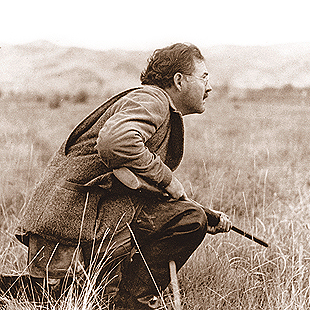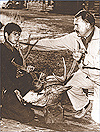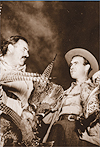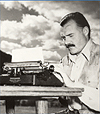| Current Issue |
| features |
| Hemingway's autumns |
| The Aspen Tree |
| Rocky Mountain Elk |
| Kevin Syms |
| Rember's 'Traplines' |
| Views and Windows |
| Mountain Weather |
| Idaho Trout |
| calendar |
| Fall 2005 |
| listings |
| Galleries |
| Dining |
| Lodging |
| maps |
| Gallery Map |
| the guide |
| Last Summer |
| Advertising |
| About Us |
|
Copyright
© 2005 Express Publishing Inc. All Rights reserved. Reproduction in whole or in part in any form or medium without express written permission of Express Publishing Inc. is strictly prohibited. The Sun Valley Guide magazine is distributed free twice yearly to residents and guests throughout the Sun Valley, Idaho resort area communities. Subscribers to the Idaho Mountain Express newspaper will receive the Sun Valley Guide with their subscription. |


Photo by Robert Capa © 2001 Cornell
Capa/Magnum Photos
'Best
of all
he loved the fall'
Ernest Hemingway's autumns in Idaho
By Gregory Foley
On a warm autumn day in 1939, Ernest Hemingway stood in the Ketchum Cemetery and methodically read aloud what some local friends believed to be one of his finest works of prose. It was a eulogy for his friend Gene Van Guilder, a publicist for Sun Valley Resort who had been killed in a tragic bird-hunting accident in the Hagerman Valley, near Twin Falls.
Hemingway praised Van Guilder’s talents, as a writer, artist and communicator, and in uncommonly lyrical verse painted an indelible image of his friend’s deep love for the landscape of central Idaho.
“He loved the warm sun of summer and the high mountain meadows, the trails through the timber and the sudden clear blue of the lakes. He loved the hills in the winter when the snow comes,” Hemingway said. “Best of all he loved the fall … the fall with the tawny and grey, the leaves yellow on the cottonwoods, leaves floating on the trout streams and above the hills the high blue windless skies. He loved to shoot, he loved to ride and he loved to fish.”
Later, some Hemingway scholars and acquaintances came to believe that Papa—as he was known to family and friends—did not write the eulogy only for Van Guilder, whom he knew only for a short time, but also for himself. Indeed, the words strike several of the chords that were the complex symphony of Hemingway’s life. And although Hemingway had many interests—from writing, women and wine to watching bullfights and fishing for giant marlin—from that fall of 1939 until his death, spending the autumn “shooting season” in the heart of Idaho repeatedly captured his focus.
“I think the fall was his favorite season,” said Pat Hemingway, 77, Hemingway’s only living son. “That shows up in his writing.”
Pat, who retired to Montana in 1975 after careers as a safari outfitter and wildlife management instructor in East Africa, said his father was very much at home in the Idaho mountains from 1939 to 1947, when Papa spent five fall seasons in Sun Valley and Ketchum. “He was very fond of that area. He had a lot of good friends in Ketchum,” he said. “My fondest memories really are of those early years, before the war.”
Ernest Hemingway first came to Sun Valley in September 1939. He had been invited to stay at the new Sun Valley Lodge as a guest after Van Guilder determined he would enjoy the hunting in the area and would generate good publicity for the resort.
Pat Hemingway—who had his own nickname, Mouse—said Papa was in all likelihood attracted to the area not only by the offer from the resort, but also his friendship with poet Ezra Pound, who was from Hailey. And, during that fall, Papa was becoming estranged from his second wife, Pauline Hemingway, Pat’s mother. “When that broke up he had to have somewhere to go,” Pat said.

Pat Hemingway watches proudly as Papa measures the rack of a mule deer Pat shot in October 1946. The buck was Pat's first big game trophy. Photo by Lloyd Arnold, Courtesy of Regional History Dept, The Community Library
In those early years, Hemingway was at a high point in his writing career, enjoying a certain degree of fame as he worked on what some critics have hailed as his best full-length novel, “For Whom the Bell Tolls.” Every day, Papa wrote or edited in the morning hours until about noon, and then made his way outdoors, often to hunt.
“I think he was in search of the vanishing frontier,” said Marty Peterson, a Hemingway scholar and assistant to the president of University of Idaho. “I think he was in search of a place where he could have some anonymity, where the hunting and fishing was still good. And he found that in Central Idaho.”
Hemingway immediately met a band of friends in Sun Valley. The group included Sun Valley Resort’s chief guide, Taylor Williams, resort photographer Lloyd Arnold, Arnold’s wife, Tillie Arnold, and eventually, a young Picabo rancher named Bud Purdy.
In the fall of 1939, Hemingway stayed with his girlfriend, writer and journalist Martha Gellhorn, in Suite 206 of the Sun Valley Lodge, which he soon dubbed “Glamour House.” Hemingway worked diligently on “For Whom the Bell Tolls,” and soon became enamored with duck hunting at Silver Creek, near Picabo, and pheasant hunting at points south, near Shoshone, Dietrich and Gooding.
Purdy, who at 87 still manages thousands of acres of ranchland around Silver Creek, said Hemingway seemed to like the area because of its geography—which reminded him of Spain—and the people—who were friendly, a little rough around the edges and didn’t make a fuss about his celebrity. Purdy often took Hemingway hunting for ducks, mostly mallards, on Silver Creek, a popular waterfowl migration stop.
“We just jump shot,” Purdy said. “He didn’t like sitting in the blind. … He was a good guy to be out with.”
That November, after Van Guilder’s funeral, Gellhorn left for Scandinavia on a work assignment. Through the rest of an Indian summer, Hemingway hunted, read and completed numerous chapters of “For Whom the Bell Tolls” before leaving Sun Valley in December to return to his home in Cuba.
Hemingway returned to Sun Valley Resort the following September with Gellhorn and his three sons, Jack, Pat and Gregory. He completed editing work on “For Whom the Bell Tolls,” played tennis and hunted birds, at times with a new friend, actor Gary Cooper. He and his family returned again in the fall of 1941.
Pat Hemingway said Papa taught his sons how to shoot and hunt, generously allowing them to discharge 200 or 300 rounds of ammunition per day. Being a “social hunter,” Papa liked having his kids and friends around, but also liked his hunts to be well organized. “We mostly hunted ducks, doves and pheasants,” he said. “And we did a lot of rabbit hunting in those days.”
Rabbit hunting was common in the early 1940s, Pat Hemingway said, when the animals—some of them diseased—would descend upon agricultural lands by the thousands. Indeed, Purdy recalled one rabbit hunt in the Dietrich area during which a group of 20 or so hunters, including Hemingway and Cooper, shot about 400 or 500 of the rodents.
Purdy said Hemingway enjoyed the art of hunting but was also fond of shooting.
“He liked to hunt not just to kill stuff,” Purdy said. “It was the thrill of the hunt. A lot of times he didn’t get a lot of birds and he didn’t seem to mind that.”
In the fall of 1941, Hemingway enjoyed one of his finest moments while hunting in Idaho. In the Pahsimeroi Mountains, near Challis, he was stalking antelope with his sons and some hunting friends from Sun Valley, including Lloyd Arnold.
Hemingway and his boys were trailing Arnold, who was trying to capture a few images of the pronghorns, Arnold recalled in his book “High on the Wild with Hemingway.” After Arnold’s metal lens cast a reflection of the sun, the antelope ran. Arnold motioned for Hemingway to make his move and he did, cursing as he passed Arnold some 20 yards, before halting, raising his rifle and firing a single shot cleanly into the shoulder of a large buck.
Hemingway stood proudly and then asked Arnold how far away he was when he shot. Arnold measured the distance at 275 yards. According to Arnold, Hemingway said, “I’ve made fair shots in my time but this ranks them all.”
The only story Hemingway ever wrote about Idaho, called “The Shot,” loosely described the Pahsimeroi hunt, including a Saturday night bar fight in the mining town of Patterson, during which Papa reportedly dropped a huge, angry miner with several left hooks. It was published in “True” magazine in April 1951. “He always prided himself on being a very good rifle shot,” Pat Hemingway said.
During World War II and until the fall of 1946, Hemingway was unable to get back to Idaho. Once, after his return, Purdy said Papa went down to Silver Creek and discovered the rancher tending to some traps he had set for magpies, predatory birds that were considered pests.
“He looked over at these traps and said, ‘What do you do with those magpies?’” Purdy recalled. “I said we just wring their necks. He said, ‘Why don’t we let ’em out and shoot ’em.’
“So, we’d have a hundred in a trap. We’d let one of the kids throw them up in the air and we’d practice live trap-shooting. He was a good shot. Hemingway was the champion magpie shooter.”
Although some evidence suggests Hemingway sometimes loved to shoot for shooting’s sake, there is no doubt his time in Idaho revealed a gentler side. Purdy said he made friends easily and always spoke in a quiet voice. In addition, he said, Hemingway never boasted about his work or his stature as a writer, even after he won the Nobel Prize for Literature in 1954.
“He never talked about his writing,” Purdy said. “And we never talked about politics. I think he was a Democrat, but I’m not sure of that … He was a real gentleman, I think.”
The only time Hemingway spoke about his writing to Purdy, the rancher recalled, was during a lunch one day at the Alpine Club in downtown Ketchum, now Whiskey Jacques.
“He decided he wanted something to drink, so he went across the street to get some wine,” Purdy said. “He was really feeling good. He said, ‘I wrote a thousand words today and it’s worth a dollar a word.’”
Hemingway “liked to party,” Purdy noted, but never drank while they were out hunting, with exceptions amounting to a few sips from a bota bag when all the shooting was done. “He wasn’t an alcoholic at all. No way,” Purdy said.

Ernest Hemingway, left, and Gene Van Guilder show off their bounty on the opening day of pheasant hunting in 1939. Photo Courtesy of Regional History Dept, The Community Library
During the fall of 1946, Hemingway and his fourth wife, Mary, stayed at MacDonald Cabins, on the south side of Ketchum—now the Ketchum Korral. He worked on “The Garden of Eden,” a novel he never finished but which was ultimately complete enough to be published posthumously in 1986. Hemingway returned to Ketchum and Sun Valley in the fall of 1947 and stayed through Christmas that year. During that stay, he enjoyed the company of Hollywood stars such as Cooper and Ingrid Bergman, who played the lead roles in the film version of “For Whom the Bell Tolls.”
At times, he continued work on the “The Garden of Eden,” Peterson said, “cranking out 800 words a day.”
In 1946 and 1947, Hemingway’s doctor in Sun Valley forbid him to go hunting in the mountains; he had put on weight and his blood pressure was high. Still, he ventured out to shoot ducks and pheasants.
Purdy said Hemingway would hang his game birds by the head for three or four days to let the meat age and would then incorporate them into sundry feasts. “He really liked duck. But they had to be almost raw,” Purdy said.
After leaving Idaho in January 1948, Hemingway did not return for a decade. During those times, Peterson said, Hemingway was busy with numerous projects and settled into his life in Cuba, where he pursued perhaps his greatest outdoor passion, deep-sea fishing. He wrote “Across the River and Into the Trees” and “The Old Man and the Sea,” a novella that won the Pulitzer Prize in 1953.
In the fall of 1958, Hemingway returned to the Wood River Valley and continued to hunt.
According to friend Tillie Arnold, now deceased, one day at Silver Creek Hemingway shot and injured an owl in the wing, thinking he could use it as a live decoy to attract and shoot crows for sport. The owl ultimately became a pet, named Owlny. “He would shoot blackbirds at Silver Creek to feed the owl,” Purdy said.
Ultimately, when Purdy started trapping magpies, the owl was no longer needed and was eventually set free, the story goes.
In 1959, Ernest and Mary Hemingway purchased for $50,000 a house outside Ketchum along the Big Wood River. It had excellent views of the river and the nearby Boulder Mountains.
To a friend, Gen. Buck Lanham, Hemingway wrote: “This place ... was a wonderful buy. I plan to live here in the shooting months, which correspond to the hurricane months and the early northers in Cuba. My health and Mary’s needs a change of climate from the subtropics for part of each year.”
While residing at his Ketchum estate, Peterson said, Hemingway worked on “The Garden of Eden” and did a substantial amount of editing and rewriting on “A Moveable Feast,” a lively memoir of his early days as a writer in Paris.
But all was not well. Friends and family noticed changes in Papa as he battled various health ailments. And, he was having trouble writing.
“You must remember that he was pretty well a broken person when he came to Idaho in those final years,” Pat Hemingway said.
Ernest Hemingway died of a self-inflicted gunshot wound in the front foyer of his Ketchum house in July 1961. He was 61 years old.
“The ending of his life was kind of traumatic to me. He was such a great guy,” Purdy said. “I guess if he couldn’t write, it got so life wasn’t worth living for him.”
Pat Hemingway said if there is one thing people should recognize about Papa, it should not be that he was a great hunter, fisherman or father; it should be that he was a writer who crafted stories like few others could.
“He was to writing what Einstein was to physics,” he said. “He was undoubtedly one of the greatest writers in the 20th century in any language.”
Hemingway was buried in the Ketchum Cemetery, not far from the grave of Gene Van Guilder.
About five years later, a memorial to Hemingway was erected east of Ketchum, near the Sun Valley Lodge. It is a simple bust of the author, carrying an edited excerpt from the Van Guilder eulogy that starts with the words, “Best of all he loved the fall.”
Hemingway:
Separating fact from fiction
By Gregory Foley
and Marty Peterson
 Photo
Courtesy of Regional History Dept, The Community Library
Photo
Courtesy of Regional History Dept, The Community Library
Ernest Hemingway lived a life that seemed somehow larger than life. He was not only the preeminent writer of his time—a recipient of the Pulitzer Prize and Nobel Prize for Literature—he ran with the bulls in Pamplona, Spain, hunted big game in Africa, adorned the cover of “Life” magazine, was injured in combat and mingled with celebrities.
Nonetheless,
despite all of the research that has been directed toward establishing a
comprehensive record of Hemingway’s life and times, myths about the
writer—both great and small—have been perpetuated over the decades since
his death. Marty Peterson, assistant to the president of the University
of Idaho and a respected Hemingway scholar, through years of study
discovered that some of those myths involved Hemingway’s time in Idaho.
Here are some of the myths Peterson has been trying to dispel:
Fiction: Hemingway became a legal resident of Idaho.
Fact: He owned a state liquor permit (which allowed him to buy
liquor in the state dispensary), and owned stock in Idaho Power, but he
never had an Idaho driver’s license, had a non-resident hunting and
fishing license and never registered to vote in Idaho.
Fiction: Hemingway came to Idaho only because Sun Valley Lodge offered him free lodging.
Fact: While the offer of free lodging did prompt him to finally
go to Idaho, he had expressed interest in visiting the state as far back
as 1928.
Fiction: Ernest Hemingway liked to visit Idaho to ski with other celebrities at Sun Valley.
Fact: Hemingway was an avid skier in his youth and took winter
ski trips to the Alps when he was living in Paris with his first wife,
Hadley, but he never skied at Sun Valley.
Fiction: When Ernest Hemingway posed for a photo shoot while fishing in the Big Wood River, it was the only time he fished in Idaho.
Fact: A January 1958 issue of “The Fisherman” magazine featured a
story by Hemingway’s friend Taylor Williams. In the article, Williams
describes at length his experiences fishing with Hemingway in the Big
Wood River and Silver Creek.
Fiction: Hemingway is not considered an Idaho author because none of his published works were written in Idaho.
Fact: Hemingway wrote portions of “For Whom the Bell Tolls,”
“Islands in the Stream” and “The Garden of Eden” while in Idaho, and
also worked extensively on “A Moveable Feast.” •